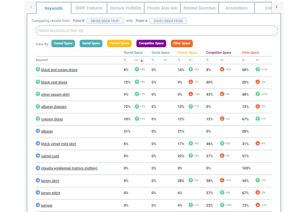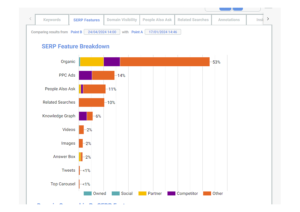SERP volatility refers to the degree of fluctuation in search engine rankings for specific terms. When volatility is high, search results for a particular query change frequently.
This is important to know because the volatility can impact rankings and visibility. Content shifts in position on the SERP. Volatility is affected by algorithm updates, search volume changes, emergence of new SERP features.
If you’ve seen sudden changes to your keyword rankings or page one visibility, which in turn might affect conversion rates, it’s highly likely you’ve encountered SERP volatility.
While it’s normal in today’s competitive SEO landscape, monitoring and optimizing your content can help stabilize keyword rankings over the long term.
Some SERPs are basically the same every day no matter what. But others might change hourly. It’s important to know the volatility of SERPs for your keywords so that you can move quickly to mitigate any loss in visibility.
Understanding volatility is important for digital marketing
Using SERPsketch you can visualise changes in the SERP quickly and easily, so that you can identify how volatile your SERPs are.
- If SERPsketch shows stable performance after weeks or months, and suddenly traffic to your site drops off a cliff, or conversion rates suddenly decrease, checking in SERPsketch to see if any changes in the SERP could be the cause is very helpful. It either eliminates or confirms any concerns about the SERP.
- It’s hard to forecast the results of changes in your SEO strategy because you simply don’t know how quickly changes might come into effect. Essentially you have to beat someone else’s strategy to win. SERPsketch helps you clearly identify who your competitors are, how much share of the page they own and helps you determine whether there’s a chance to win for that keyword.
- Some SERPs have changing intent which affects visibility. For example, the phrase “talent management.” Years ago that term would have been related to entertainment talent management but now it’s a common HR term, replacing recruitment or HR. If a SERP has got changing intent, often new SERP features will appear and be tested. Another example is terms around socks. Before the Covid pandemic, searching for “socks” would provide results with a map pack showing where to buy your socks. People typically went into stores to buy their socks. Once Covid hit, that all changed. Socks lost the local intent and there’s now no map pack.
- When Google introduces new SERP features this also impacts visibility and can show volalility in SERPs. Google introduced a holiday booking feature where you could do your search and booking almost all from within the Google browser. This would then have affected SERPs for holiday search terms and rankings and visibility have significantly decreased for holiday sites.
Try SERPsketch
Using SERPsketch to monitor the volatility of SERPs across an entire keyword set is really useful. Rather than having to look at individual keywords, you can tell whether across your keywords there’s volatility and then use the individual keyword reports to drill down further.
Get a free trial of SERPsketch today.




